Frog Machine
frog machine

Credit to @ArtFromRachel on Twitter
More Posts from Dipstickflopdoodle and Others
Ok so when YOU put on skits for your family, your parents think you’re cute and show you “love” and “affection.” But when I do it, it’s all “what means this play?” and “u have to go to england for committing treason”
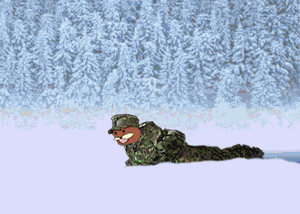


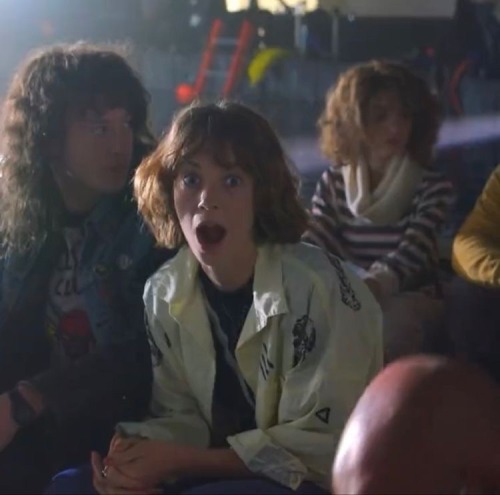

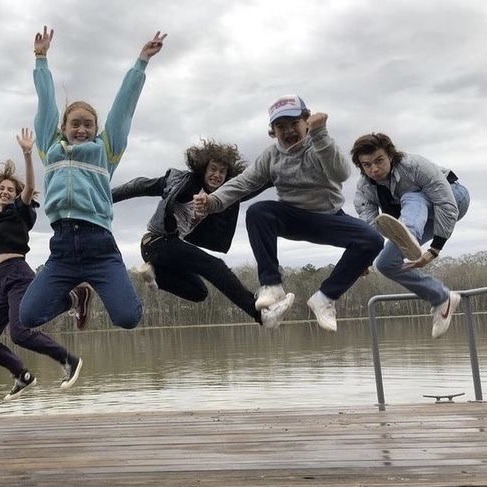





POV: Scrolling through Steve Harrington’s camera roll
Glowy dark mode site skin
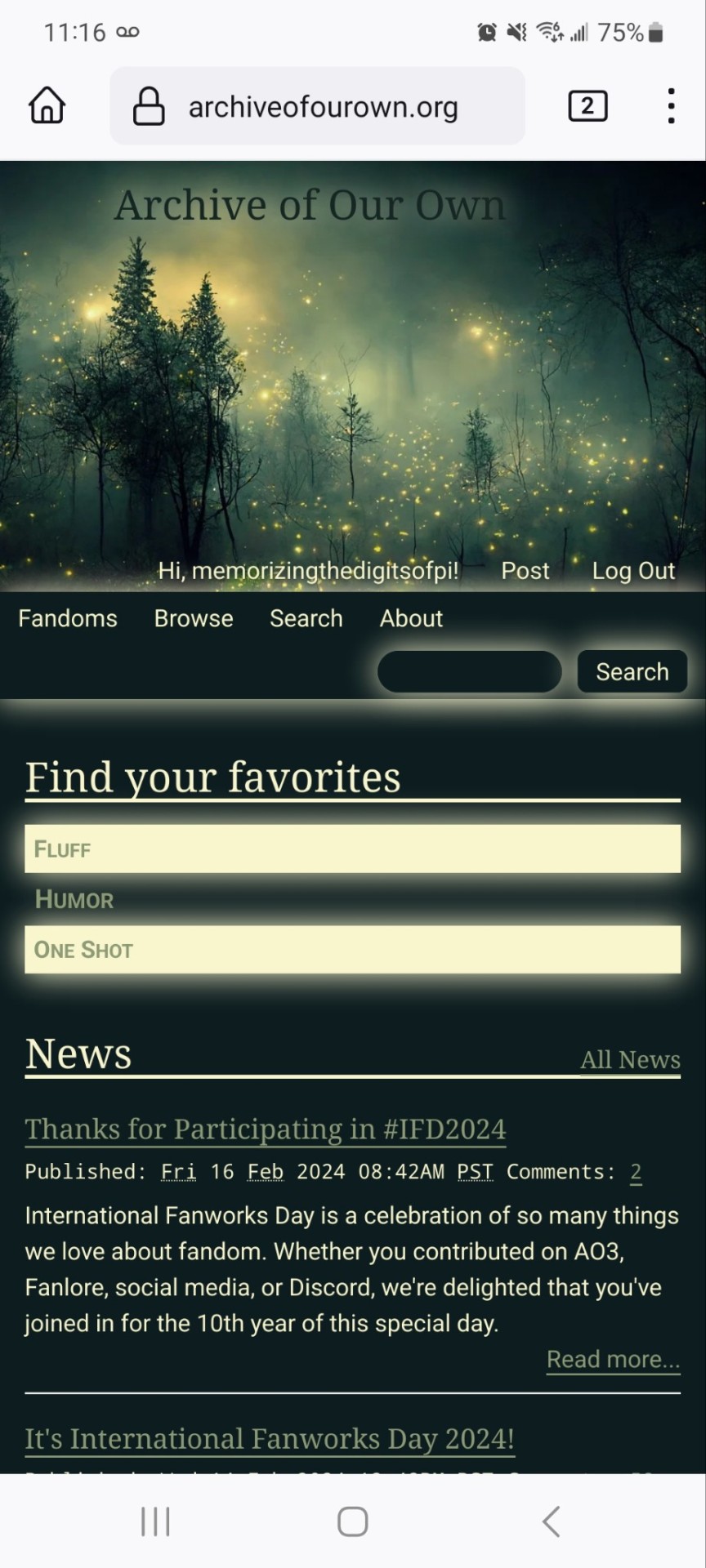
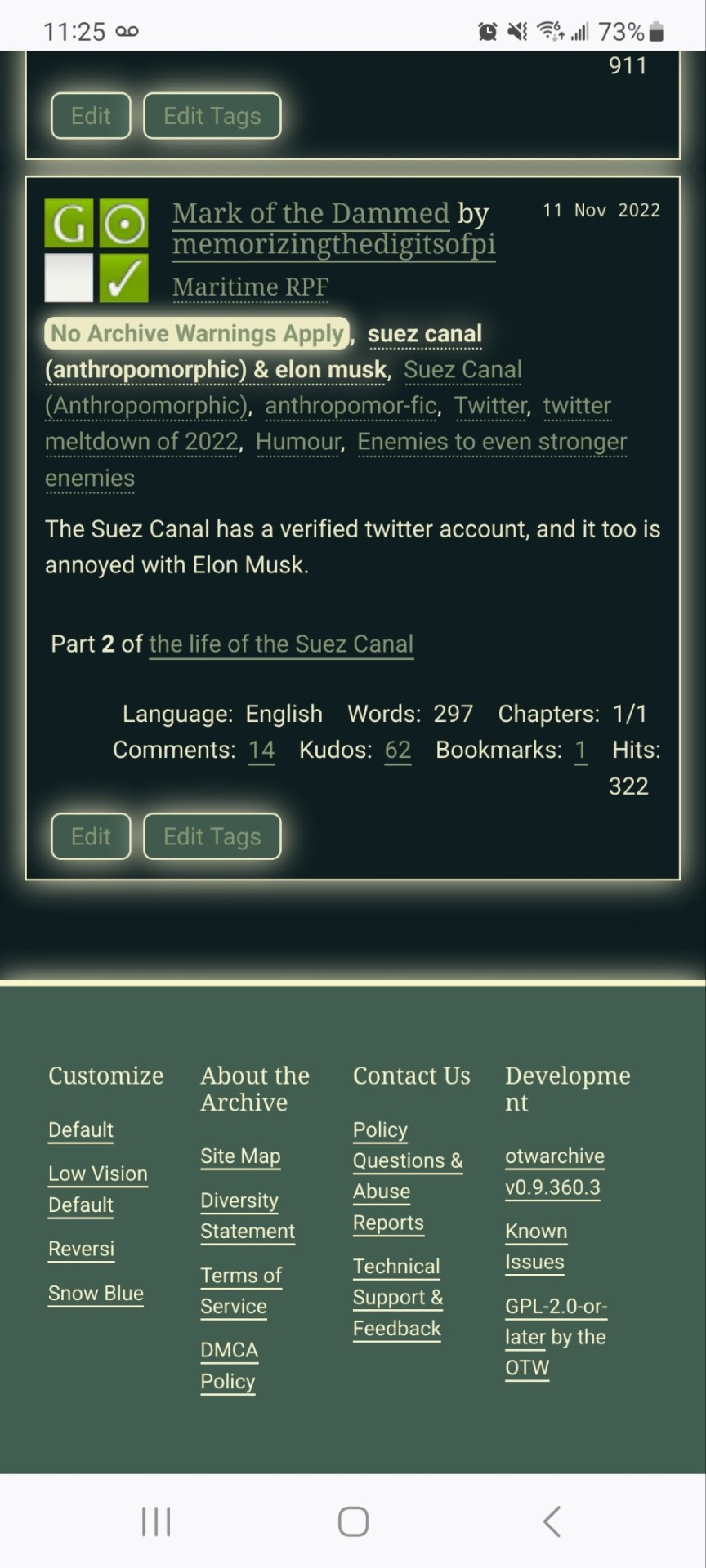


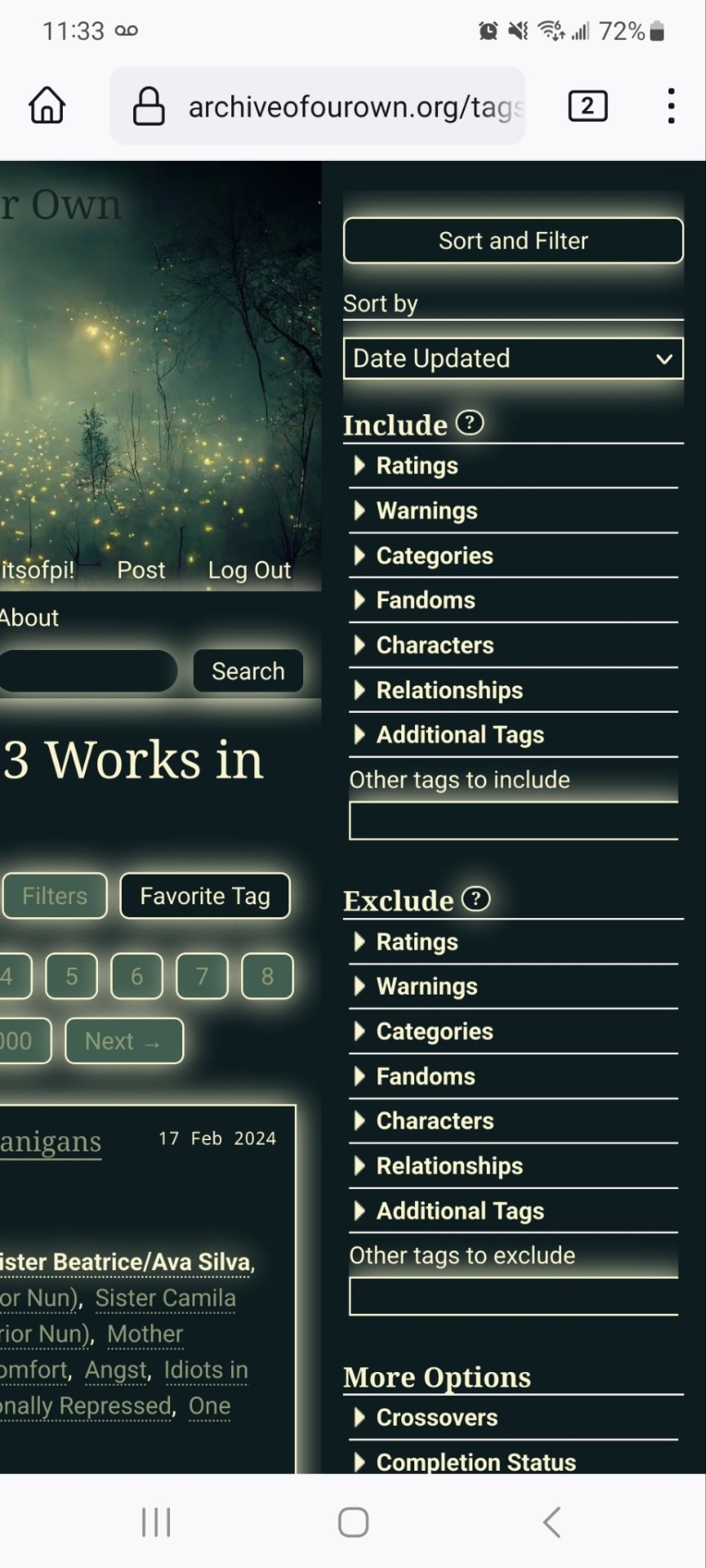
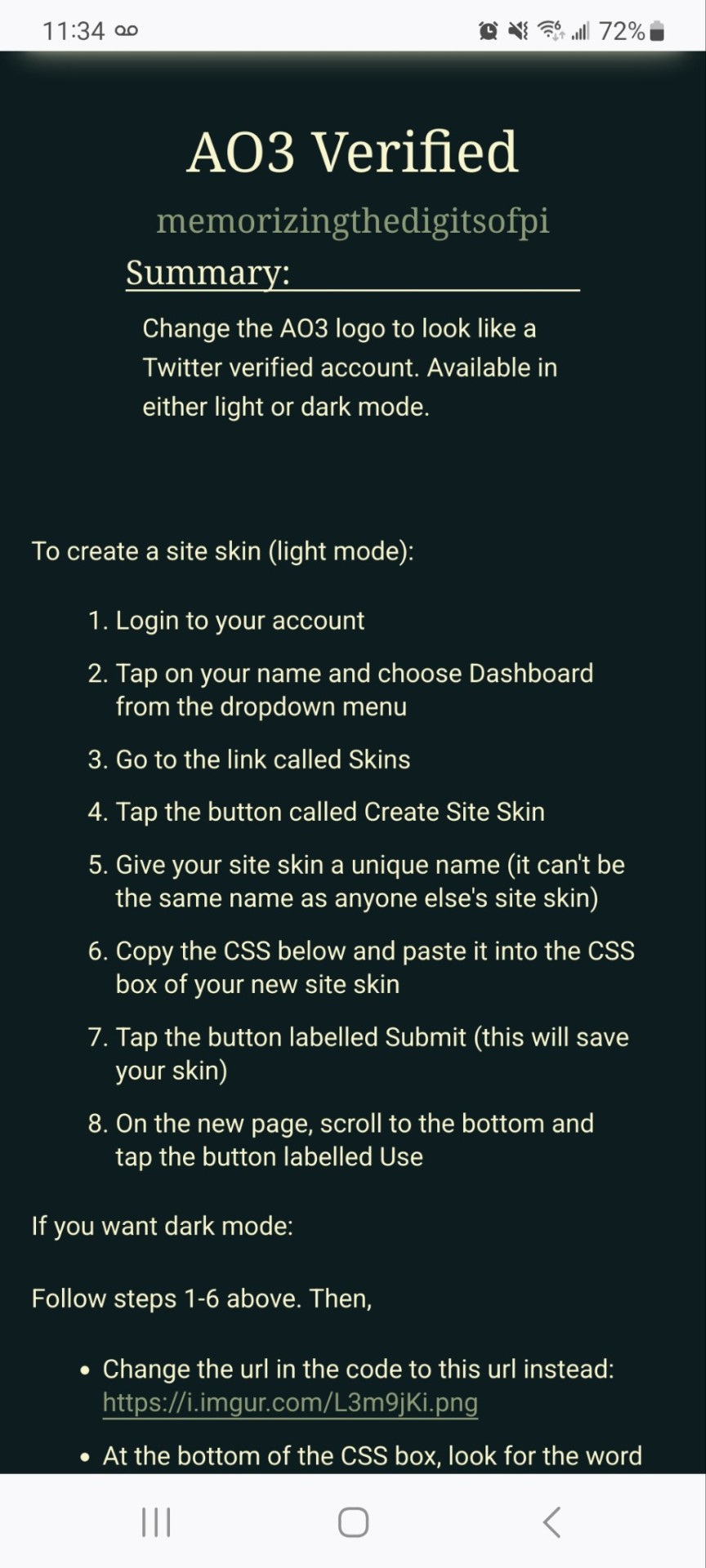
🎼 You would not believe your eyes, if 10 million fireflies ended up in the header of your AO3. 🎶
It's been a while since I tried glow effects, but I saw the fireflies and I couldn't resist.
CSS code under the cut.
#header { background-image: url("https://cdn.pixabay.com/photo/2022/10/19/16/56/fireflies-7533056_1280.jpg"); background-repeat: no-repeat; background-size: cover; background-position: center center; background-color: #152623; }
#header .heading { height: 15em; }
#header .primary { background: #0d1d1f; box-shadow: 0px 0px 15px #f9f6ce; }
#header .logo, #header .heading sup { visibility: hidden; }
#header .heading a { color: #152623; text-shadow: 0px 0px 15px #f9f6ce; }
.event .userstuff { background: #425e50; border: 1px solid #f9f6ce; }
#outer.wrapper { background: #0d1d1f; color: #f9f6ce; }
#main a { color: #8c9b76; }
#greeting a.dropdown-toggle, #header .actions a { color: #f9f6ce !important; text-shadow: 0px 0px 3px #152623; }
#greeting .menu, #header .dropdown .menu, #header .dropdown:hover a { background: #0d1d1f; box-shadow: 0px 0px 15px #f9f6ce; }
span.submit.actions input.button { display: none; }
#greeting img.icon { display: none; }
#header #search .text, .search [role="tooltip"] { background: #0d1d1f; box-shadow: 0px 0px 15px #f9f6ce; color: #f9f6ce !important; border: 1px solid #0d1d1f; }
form.search input[type=text], form.search input[type=submit], .autocomplete div.dropdown ul { background: #0d1d1f !important; border: none; box-shadow: 0px 0px 15px #f9f6ce; color: #f9f6ce; display: block; }
#header #search .text { width: 7em; }
.notice, .comment_notice, .kudos_notice, ul.notes, .caution, .error, .comment_error, .kudos_error, .alert.flash { background: #f9f6ce; box-shadow: 0px 0px 15px #f9f6ce !important; color: #0d1d1f; border: none; }
.notice a, .comment_notice a, .kudos_notice a, ul.notes a, .caution a, .error a, .comment_error a, .kudos_error a, .alert.flash a { color: #506957; font-weight: bold; }
.splash .module h3 { color: #f9f6ce; border-bottom: 2px solid #f9f6ce; }
.splash .favorite li:nth-of-type(2n+1) a { background: #f9f6ce; box-shadow: 0px 0px 15px #f9f6ce; color: #0d1d1f; font-weight: bold; font-variant: small-caps; }
.splash .favorite li:nth-of-type(2n+2) a { color: #f9f6ce; font-weight: bold; font-variant: small-caps; font-size: 110%; }
.splash .favorite li:nth-of-type(2n+1) a:hover, .splash .favorite li:nth-of-type(2n+2) a:hover { color: #f9f6ce; font-weight: bold; font-variant: small-caps; background: #425e50; }
#footer { background: #425e50; color: #f9f6ce; border-top: 3px solid #f9f6ce; box-shadow: 0px 0px 15px #f9f6ce; }
#footer a, #footer .heading { color: #f9f6ce; }
.actions a, .actions a:focus, .actions input:focus, .action:focus, .actions li input, .actions li input[type="submit"], input[type="submit"], .actions li label, ul.navigation.actions li a, .action:link, .actions a:link { background: #425e50; border: 1px solid #f9f6ce; color: #f9f6ce; box-shadow: 0px 0px 15px #f9f6ce; border-radius: 5px; }
.current, #dashboard .current { background: #f9f6ce !important; color: #0d1d1f !important; box-shadow: 0px 0px 15px #f9f6ce !important; border-radius: 5px; }
#dashboard.own { border-top: 5px solid #f9f6ce; border-bottom: 5px solid #f9f6ce; box-shadow: 0px 0px 15px #f9f6ce; }
#dashboard a:hover { background: #0d1d1f; box-shadow: 0px 0px 15px #f9f6ce; }
#dashboard a { color: #f9f6ce; }
dl.meta { border: 1px solid #f9f6ce; box-shadow: 0px 0px 15px #f9f6ce; }
.listbox .index { background: #0d1d1f; }
.listbox, fieldset fieldset.listbox { background: #f9f6ce; box-shadow: 0px 0px 15px #f9f6ce; }
form dl, fieldset, fieldset fieldset, fieldset fieldset fieldset, fieldset fieldset dl dl, dd.hideme, form blockquote.userstuff, input, select, select:focus, textarea, span.symbol.question, .own { background: #0d1d1f !important; color: #f9f6ce !important; border: 1px solid #f9f6ce; box-shadow: 0px 0px 15px #f9f6ce; }
.autocomplete li.added, .post .meta dd ul li.added, label, label.required { color: #f9f6ce; }
span.delete { background: #f9f6ce; box-shadow: 0px 0px 15px #f9f6ce; }
span.delete a { color: #0d1d1f !important; font-weight: bold; }
.ui-sortable li, .dynamic form, div.dynamic { background: #0d1d1f; border: 1px solid #f9f6ce; }
.dropdown { background: #0d1d1f; }
form.verbose legend, .verbose form legend { background: #f9f6ce; color: #0d1d1f; box-shadow: 0px 0px 15px #f9f6ce; }
li.blurb { border: 1px solid #f9f6ce; box-shadow: 0px 0px 15px #f9f6ce; }
.draft { background: #0d1d1f; color: #f9f6ce; border: 2px dashed #f9f6ce; box-shadow: 0px 0px 15px #f9f6ce; }
.draft .wrapper { background: #0d1d1f; border: 1px solid #f9f6ce; }
#header h2 { background: #f9f6ce !important; color: #0d1d1f; box-shadow: 0px 0px 15px #f9f6ce; }
#stat_chart svg rect:first-of-type { opacity: 60%; }
#stat_chart g[clip-path^=url] > g:nth-of-type(2) rect, #stat_chart svg g:nth-of-type(2) > g rect:last-of-type, #stat_chart g[clip-path^=url] > g:nth-of-type(2) rect:first-of-type { filter: hue-rotate(140deg); opacity: 80% !important; }
.statistics .index li:nth-of-type(2n) { background: #0d1d1f; border: 1px solid #f9f6ce; }
.reading h4.viewed, dl.index dd, table, th, dt.child { background: #0d1d1f; }
#modal, span.replied { background: #0d1d1f; color: #f9f6ce; border: 2px solid #f9f6ce; box-shadow: 0px 0px 15px #f9f6ce; }
h4.heading.byline { background: #f9f6ce; color: #0d1d1f; }
li.comment { border: 1px solid #f9f6ce; }
.comment div.icon { border-bottom: 5px solid #f9f6ce; box-shadow: 0px 0px 15px #f9f6ce; }
.thread .even { background: #425e50; }
.unread { background: #0d1d1f; border: 5px dashed #f9f6ce !important; }
span.unread { background: #f9f6ce; color: #0d1d1f; }
span.indicator::before { box-shadow: 0px 0px 15px #f9f6ce; }
.warnings .tag, .work .warning a.tag, dd.warning.tags a { border: 1px solid #f9f6ce; border-radius: 5px; background: #f9f6ce; padding-left: 2px; padding-right: 2px; box-shadow: 0px 0px 10px #f9f6ce; }
.relationships .tag, .work .relationships a.tag, dd.relationship.tags a { background: none; color: #f9f6ce !important; font-weight: bold; text-shadow: 0px 0px 15px #f9f6ce; }
.filters .expander { background: url("https://64.media.tumblr.com/3c89981f933f9f57157d6dcec6fd85a7/94c6737c6db9ad60-e5/s1280x1920/f7557e617a5439c506721bd326580a0cb4c1f8d8.png") left center no-repeat; color: #f9f6ce !important; font-weight: bold; }
.filters .expanded .expander { background: url("https://64.media.tumblr.com/dab095a2fd9387bc1e0c57747ba6b13f/94c6737c6db9ad60-ad/s1280x1920/c1a4e14e0565cdcac5d3e20bebac3ab440f2d607.png") left center no-repeat; }
You show up to your gf’s place with roses. I show up with my doublet all unbraced, no hat upon my head, my stockings foul'd (pissed myself) ungarter'd, and down-gyved to my ankle, pale as my shirt, my knees knocking each other, and with a look so piteous in purport as if I had been loosed out of hell to speak of horrors.
Kitchen witching is one of my favorites tbh 🫖


Words for Skin Tone | How to Describe Skin Color
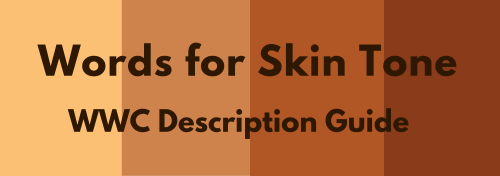
We discussed the issues describing People of Color by means of food in Part I of this guide, which brought rise to even more questions, mostly along the lines of “So, if food’s not an option, what can I use?” Well, I was just getting to that!
This final portion focuses on describing skin tone, with photo and passage examples provided throughout. I hope to cover everything from the use of straight-forward description to the more creatively-inclined, keeping in mind the questions we’ve received on this topic.
Standard Description
Basic Colors

Pictured above: Black, Brown, Beige, White, Pink.
“She had brown skin.”
This is a perfectly fine description that, while not providing the most detail, works well and will never become cliché.
Describing characters’ skin as simply brown or beige works on its own, though it’s not particularly telling just from the range in brown alone.
Complex Colors
These are more rarely used words that actually “mean” their color. Some of these have multiple meanings, so you’ll want to look into those to determine what other associations a word might have.

Pictured above: Umber, Sepia, Ochre, Russet, Terra-cotta, Gold, Tawny, Taupe, Khaki, Fawn.
Complex colors work well alone, though often pair well with a basic color in regards to narrowing down shade/tone.
For example: Golden brown, russet brown, tawny beige…
As some of these are on the “rare” side, sliding in a definition of the word within the sentence itself may help readers who are unfamiliar with the term visualize the color without seeking a dictionary.
“He was tall and slim, his skin a russet, reddish-brown.”
Comparisons to familiar colors or visuals are also helpful:
“His skin was an ochre color, much like the mellow-brown light that bathed the forest.”
Modifiers
Modifiers, often adjectives, make partial changes to a word.The following words are descriptors in reference to skin tone.
Dark - Deep - Rich - Cool
Warm - Medium - Tan
Fair - Light - Pale
Rich Black, Dark brown, Warm beige, Pale pink…
If you’re looking to get more specific than “brown,” modifiers narrow down shade further.
Keep in mind that these modifiers are not exactly colors.
As an already brown-skinned person, I get tan from a lot of sun and resultingly become a darker, deeper brown. I turn a pale, more yellow-brown in the winter.
While best used in combination with a color, I suppose words like “tan” “fair” and “light” do work alone; just note that tan is less likely to be taken for “naturally tan” and much more likely a tanned White person.
Calling someone “dark” as description on its own is offensive to some and also ambiguous. (See: Describing Skin as Dark)
Undertones
Undertones are the colors beneath the skin, seeing as skin isn’t just one even color but has more subdued tones within the dominating palette.
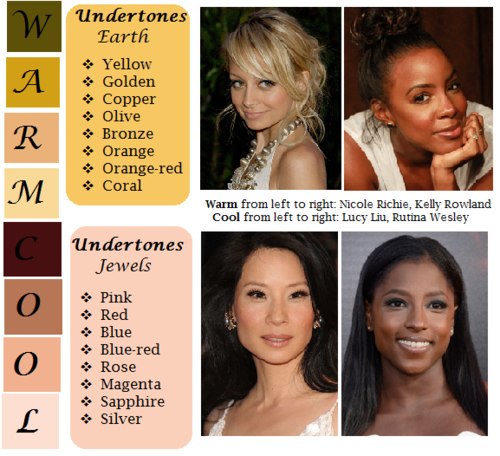
pictured above: warm / earth undertones: yellow, golden, copper, olive, bronze, orange, orange-red, coral | cool / jewel undertones: pink, red, blue, blue-red, rose, magenta, sapphire, silver.
Mentioning the undertones within a character’s skin is an even more precise way to denote skin tone.
As shown, there’s a difference between say, brown skin with warm orange-red undertones (Kelly Rowland) and brown skin with cool, jewel undertones (Rutina Wesley).
“A dazzling smile revealed the bronze glow at her cheeks.”
“He always looked as if he’d ran a mile, a constant tinge of pink under his tawny skin.”
Standard Description Passage
“Farah’s skin, always fawn, had burned and freckled under the summer’s sun. Even at the cusp of autumn, an uneven tan clung to her skin like burrs. So unlike the smooth, red-brown ochre of her mother, which the sun had richened to a blessing.”
-From my story “Where Summer Ends” featured in Strange Little Girls
Here the state of skin also gives insight on character.
Note my use of “fawn” in regards to multiple meaning and association. While fawn is a color, it’s also a small, timid deer, which describes this very traumatized character of mine perfectly.
Though I use standard descriptions of skin tone more in my writing, at the same time I’m no stranger to creative descriptions, and do enjoy the occasional artsy detail of a character.
Creative Description
Whether compared to night-cast rivers or day’s first light…I actually enjoy seeing Characters of Colors dressed in artful detail.
I’ve read loads of descriptions in my day of white characters and their “smooth rose-tinged ivory skin”, while the PoC, if there, are reduced to something from a candy bowl or a Starbucks drink, so to actually read of PoC described in lavish detail can be somewhat of a treat.
Still, be mindful when you get creative with your character descriptions. Too many frills can become purple-prose-like, so do what feels right for your writing when and where. Not every character or scene warrants a creative description, either. Especially if they’re not even a secondary character.
Using a combination of color descriptions from standard to creative is probably a better method than straight creative. But again, do what’s good for your tale.
Natural Settings - Sky

Pictured above: Harvest Moon -Twilight, Fall/Autumn Leaves, Clay, Desert/Sahara, Sunlight - Sunrise - Sunset - Afterglow - Dawn- Day- Daybreak, Field - Prairie - Wheat, Mountain/Cliff, Beach/Sand/Straw/Hay.
Now before you run off to compare your heroine’s skin to the harvest moon or a cliff side, think about the associations to your words.
When I think cliff, I think of jagged, perilous, rough. I hear sand and picture grainy, yet smooth. Calm. mellow.
So consider your character and what you see fit to compare them to.
Also consider whose perspective you’re describing them from. Someone describing a person they revere or admire may have a more pleasant, loftier description than someone who can’t stand the person.
“Her face was like the fire-gold glow of dawn, lifting my gaze, drawing me in.”
“She had a sandy complexion, smooth and tawny.”
Even creative descriptions tend to draw help from your standard words.
Flowers
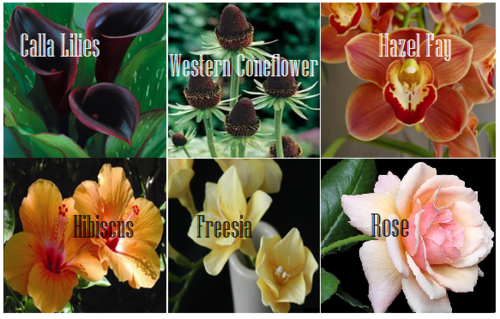
Pictured above: Calla lilies, Western Coneflower, Hazel Fay, Hibiscus, Freesia, Rose
It was a bit difficult to find flowers to my liking that didn’t have a 20 character name or wasn’t called something like “chocolate silk” so these are the finalists.
You’ll definitely want to avoid purple-prose here.
Also be aware of flowers that most might’ve never heard of. Roses are easy, as most know the look and coloring(s) of this plant. But Western coneflowers? Calla lilies? Maybe not so much.
“He entered the cottage in a huff, cheeks a blushing brown like the flowers Nana planted right under my window. Hazel Fay she called them, was it?”
Assorted Plants & Nature

Pictured above: Cattails, Seashell, Driftwood, Pinecone, Acorn, Amber
These ones are kinda odd. Perhaps because I’ve never seen these in comparison to skin tone, With the exception of amber.
At least they’re common enough that most may have an idea what you’re talking about at the mention of “pinecone.“
I suggest reading out your sentences aloud to get a better feel of how it’ll sounds.
“Auburn hair swept past pointed ears, set around a face like an acorn both in shape and shade.”
I pictured some tree-dwelling being or person from a fantasy world in this example, which makes the comparison more appropriate.
I don’t suggest using a comparison just “cuz you can” but actually being thoughtful about what you’re comparing your character to and how it applies to your character and/or setting.
Wood

Pictured above: Mahogany, Walnut, Chestnut, Golden Oak, Ash
Wood can be an iffy description for skin tone. Not only due to several of them having “foody” terminology within their names, but again, associations.
Some people would prefer not to compare/be compared to wood at all, so get opinions, try it aloud, and make sure it’s appropriate to the character if you do use it.
“The old warlock’s skin was a deep shade of mahogany, his stare serious and firm as it held mine.”
Metals

Pictured above: Platinum, Copper, Brass, Gold, Bronze
Copper skin, brass-colored skin, golden skin…
I’ve even heard variations of these used before by comparison to an object of the same properties/coloring, such as penny for copper.
These also work well with modifiers.
“The dress of fine white silks popped against the deep bronze of her skin.”
Gemstones - Minerals
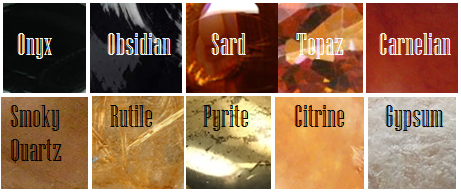
Pictured above: Onyx, Obsidian, Sard, Topaz, Carnelian, Smoky Quartz, Rutile, Pyrite, Citrine, Gypsum
These are trickier to use. As with some complex colors, the writer will have to get us to understand what most of these look like.
If you use these, or any more rare description, consider if it actually “fits” the book or scene.
Even if you’re able to get us to picture what “rutile” looks like, why are you using this description as opposed to something else? Have that answer for yourself.
“His skin reminded her of the topaz ring her father wore at his finger, a gleaming stone of brown, mellow facades.”
Physical Description
Physical character description can be more than skin tone.
Show us hair, eyes, noses, mouth, hands…body posture, body shape, skin texture… though not necessarily all of those nor at once.
Describing features also helps indicate race, especially if your character has some traits common within the race they are, such as afro hair to a Black character.
How comprehensive you decide to get is up to you. I wouldn’t overdo it and get specific to every mole and birthmark. Noting defining characteristics is good, though, like slightly spaced front teeth, curls that stay flopping in their face, hands freckled with sunspots…
General Tips
Indicate Race Early: I suggest indicators of race be made at the earliest convenience within the writing, with more hints threaded throughout here and there.
Get Creative On Your Own: Obviously, I couldn’t cover every proper color or comparison in which has been “approved” to use for your characters’ skin color, so it’s up to you to use discretion when seeking other ways and shades to describe skin tone.
Skin Color May Not Be Enough: Describing skin tone isn’t always enough to indicate someone’s ethnicity. As timeless cases with readers equating brown to “dark white” or something, more indicators of race may be needed.
Describe White characters and PoC Alike: You should describe the race and/or skin tone of your white characters just as you do your Characters of Color. If you don’t, you risk implying that White is the default human being and PoC are the “Other”).
PSA: Don’t use “Colored.” Based on some asks we’ve received using this word, I’d like to say that unless you or your character is a racist grandmama from the 1960s, do not call People of Color “colored” please.
Not Sure Where to Start? You really can’t go wrong using basic colors for your skin descriptions. It’s actually what many people prefer and works best for most writing. Personally, I tend to describe my characters using a combo of basic colors + modifiers, with mentions of undertones at times. I do like to veer into more creative descriptions on occasion.
Want some alternatives to “skin” or “skin color”? Try: Appearance, blend, blush, cast, coloring, complexion, flush, glow, hue, overtone, palette, pigmentation, rinse, shade, sheen, spectrum, tinge, tint, tone, undertone, value, wash.
Skin Tone Resources
List of Color Names
The Color Thesaurus
Skin Undertone & Color Matching
Tips and Words on Describing Skin
Photos: Undertones Described (Modifiers included)
Online Thesaurus (try colors, such as “red” & “brown”)
Don’t Call me Pastries: Creative Skin Tones w/ pics I
Writing & Description Guides
WWC Featured Description Posts
WWC Guide: Words to Describe Hair
Writing with Color: Description & Skin Color Tags
7 Offensive Mistakes Well-intentioned Writers Make
I tried to be as comprehensive as possible with this guide, but if you have a question regarding describing skin color that hasn’t been answered within part I or II of this guide, or have more questions after reading this post, feel free to ask!
~ Mod Colette


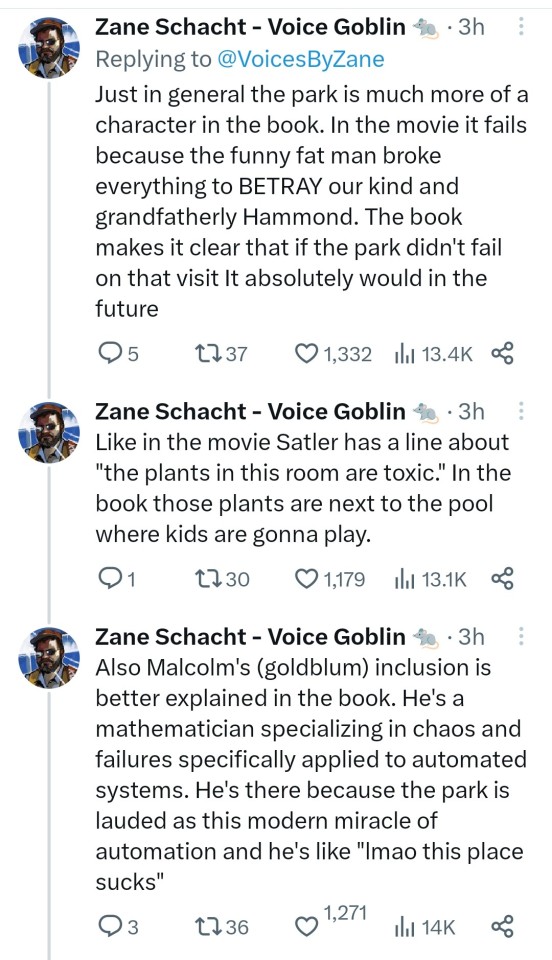






Recommended tips for research as a beginner witch/practioner:
Research as a beginner can at times feel stressful if you don't know credibilties or anything about the craft really. So, I'm going to share some tips I use in my practice and would recommend when researching witchcraft.
Research what interests you. If research begins to feel like a task instead of genuine interest or fun, there will be problems down the line with researching thoroughly. That isn't to say don't research things that bore you, it means that you should take what resonates with you and from there you can begin to build the framework for your personal craft.
Does the source align with your moral standing and personal beliefs? If the answer is no, time to find a new source. For example, if a source is fully against any harm towards another person and tries to push that narrative on the reader/viewer (or vice versa) and it's not something you personally align with, find another source. The most important example of this is many authors are bigots, terfs or cultural appropriaters. Remember to research the author and their practice before trusting what they have to say.
What may work for some people will not work for you. Do not feel inclined to do everything a certain way as said by a certain practioner. The point of witchcraft is to develop your own habits and outlooks. Crystals and astrology may work best for someone, but you may have an inclination towards herbs and palmistry for example. You do not need to practice every form of witchcraft out there. So circling back to the first point, pay mind to what sparks joy and what aligns with your abilities.
Take everything with a grain of salt. Learn to question what you learn. As witchcraft and spirituality have been practiced in many cultures for many years, things have evolved and been taken from one context to the next. Research various practices and rituals as well as the authors and cultures who promoted said practices
Use multiple sources. Blindly believing one post can be harmful, especially when concerning topics that can be a manner of physical safety (fire hazards, dressing candles, consumption and burning of herbs) or spiritual safety (spirit work, baneful work, trickster spirits). The more research the better, as it solidifies understanding too.
Do not rely solely on social media, but use it as a crutch to what you already know. Many content creators care more about views or aesthetics than educating. But many creators also DO care about what they're putting out there and have genuinely good tips and tricks for various practices. Just be wary.
Don't worry about aesthetics or perfection when you're just learning. Don't let pinterest photos of altars downplay your own craft and beauty. Right now, you're learning new topics and there's plenty of time later to find pretty altar tools or to neatly scribe in a leather journal. Don't let it distract you from research, and ultimately, the goal is to grow.
Have fun with it! There are so many research topics, and it can be as expansive or specific as you make it. Remember this isn't supposed to be stressful, it's supposed to be rewarding.
(Please add your own tips too if you'd like!)
-
 dimensionalhologram reblogged this · 3 weeks ago
dimensionalhologram reblogged this · 3 weeks ago -
 ppoppipppopipoipiippp reblogged this · 3 weeks ago
ppoppipppopipoipiippp reblogged this · 3 weeks ago -
 ppoppipppopipoipiippp liked this · 3 weeks ago
ppoppipppopipoipiippp liked this · 3 weeks ago -
 artnijna-nonartdash liked this · 3 weeks ago
artnijna-nonartdash liked this · 3 weeks ago -
 sarahpetscats liked this · 3 weeks ago
sarahpetscats liked this · 3 weeks ago -
 valamaldoran42 reblogged this · 3 weeks ago
valamaldoran42 reblogged this · 3 weeks ago -
 i-got-a-problem-with-my-heart liked this · 3 weeks ago
i-got-a-problem-with-my-heart liked this · 3 weeks ago -
 ryuutchi reblogged this · 3 weeks ago
ryuutchi reblogged this · 3 weeks ago -
 tinybunbuns liked this · 4 weeks ago
tinybunbuns liked this · 4 weeks ago -
 crimson-miz liked this · 4 weeks ago
crimson-miz liked this · 4 weeks ago -
 super-fun-fantasy-lover reblogged this · 4 weeks ago
super-fun-fantasy-lover reblogged this · 4 weeks ago -
 hustle-redbuds liked this · 4 weeks ago
hustle-redbuds liked this · 4 weeks ago -
 randomyetnot reblogged this · 1 month ago
randomyetnot reblogged this · 1 month ago -
 royalruin liked this · 1 month ago
royalruin liked this · 1 month ago -
 wordswordswordsiguess reblogged this · 1 month ago
wordswordswordsiguess reblogged this · 1 month ago -
 artistwithpurplehair liked this · 1 month ago
artistwithpurplehair liked this · 1 month ago -
 starzie reblogged this · 1 month ago
starzie reblogged this · 1 month ago -
 pergle reblogged this · 1 month ago
pergle reblogged this · 1 month ago -
 wallofmoth liked this · 1 month ago
wallofmoth liked this · 1 month ago -
 she-wu reblogged this · 1 month ago
she-wu reblogged this · 1 month ago -
 she-wu liked this · 1 month ago
she-wu liked this · 1 month ago -
 amelliiees liked this · 1 month ago
amelliiees liked this · 1 month ago -
 mooningonmoonlight liked this · 1 month ago
mooningonmoonlight liked this · 1 month ago -
 wugblogs liked this · 1 month ago
wugblogs liked this · 1 month ago -
 crushedprostate liked this · 1 month ago
crushedprostate liked this · 1 month ago -
 crushedprostate reblogged this · 1 month ago
crushedprostate reblogged this · 1 month ago -
 genderfull-raccoon liked this · 1 month ago
genderfull-raccoon liked this · 1 month ago -
 refrenceboi reblogged this · 1 month ago
refrenceboi reblogged this · 1 month ago -
 jesteroli liked this · 1 month ago
jesteroli liked this · 1 month ago -
 bluepoppyseeds reblogged this · 1 month ago
bluepoppyseeds reblogged this · 1 month ago -
 mossymissmarsh liked this · 1 month ago
mossymissmarsh liked this · 1 month ago -
 firelife14 liked this · 1 month ago
firelife14 liked this · 1 month ago -
 stitchy-queerista reblogged this · 1 month ago
stitchy-queerista reblogged this · 1 month ago -
 havzic liked this · 1 month ago
havzic liked this · 1 month ago -
 nausikaaa reblogged this · 1 month ago
nausikaaa reblogged this · 1 month ago -
 demi-chaos reblogged this · 1 month ago
demi-chaos reblogged this · 1 month ago -
 griffinborn liked this · 1 month ago
griffinborn liked this · 1 month ago -
 butchbarbieee liked this · 1 month ago
butchbarbieee liked this · 1 month ago -
 bugbugbugknight reblogged this · 1 month ago
bugbugbugknight reblogged this · 1 month ago -
 bugbugbugknight liked this · 1 month ago
bugbugbugknight liked this · 1 month ago -
 thegirlwhoshoutsaxios reblogged this · 1 month ago
thegirlwhoshoutsaxios reblogged this · 1 month ago -
 thegirlwhoshoutsaxios liked this · 1 month ago
thegirlwhoshoutsaxios liked this · 1 month ago -
 tubbawubba reblogged this · 1 month ago
tubbawubba reblogged this · 1 month ago -
 dammitjameskirk liked this · 1 month ago
dammitjameskirk liked this · 1 month ago -
 fucknugg3t liked this · 1 month ago
fucknugg3t liked this · 1 month ago -
 fucknugg3t reblogged this · 1 month ago
fucknugg3t reblogged this · 1 month ago
